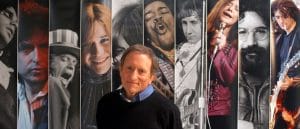Born in Ohio, Wolman learned German at the Defense Language School, joined U.S. Army Military Intelligence, and in the 1960s was stationed in West Berlin. In his off time, he took up photography, and was good: he quickly sold a photo essay about living with the Berlin Wall. Once he returned to the U.S. he worked for the photo magazines Life and Look. Living in San Francisco in the Late 1960s, when much of his photography was rock bands, he met Jann Wenner at a music concert, who was co-founding a new magazine. Wenner convinced him to work for the magazine — for free. Except Wolman had one condition: he would still own the copyright to his photos. With that, he started work on the first issue, getting a portrait of the Grateful Dead.

The magazine — Rolling Stone — was a hit. Over the next three years his work graced covers and large inside spreads: the Rolling Stones, Frank Zappa, the Who, Jimi Hendrix, Joan Baez, Iggy Pop, Pink Floyd, Bob Dylan, Phil Spector, Jim Morrison, Ike & Tina Turner, Peter Rowan, and more. “I photographed the Who smashing guitars at the Cow Palace,” he remembered. “Janis Joplin gave me a solo concert for an hour so I could photograph her singing like she was onstage.” He went on to publish many books of his photographs. “Once in a while, I’ll look back at my old copies of Rolling Stone, if a student has a question or something,” said John Burks, a former Rolling Stone editor and now a professor of journalism at San Francisco State University, “and I’m really struck by the collected works of Baron and [photographer] Jim Marshall. Rolling Stone created the language, visual and written, of that era and it seemed accidental. You can’t do that anymore.” Why not anymore? “The only way for Baron to do the work he did, so close to the performers, so lyrical and intimate, was through access,” Burks says. These days, performers are “packaged” and carefully controlled. The reality is gone. At the Classic Rock magazine’s Roll of Honour Awards in 2011, Wolman was given the VIP Award — and smashed a camera on stage in homage to the Who’s Pete Townshend. He died at his home in Santa Fe, N.M., on November 2 from ALS — amyotrophic lateral sclerosis — at 83.
